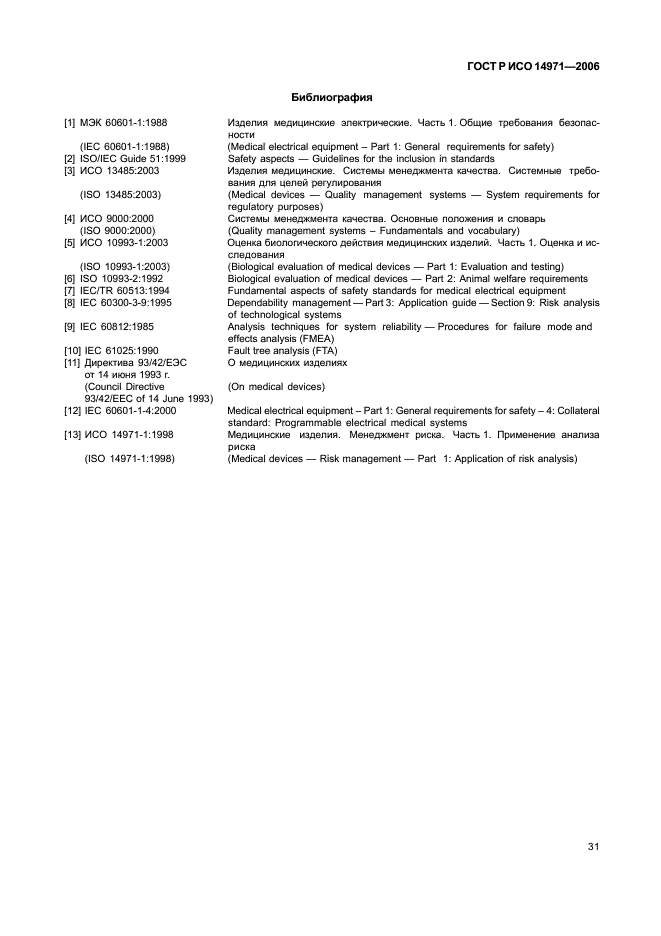ISO 14971 is an ISO standard for the application of risk management to medical devices.[1] The ISO Technical Committee responsible for the maintenance of this standard is ISO TC 210 working with IEC/SC62A through Joint Working Group one (JWG1). This standard is the culmination of the work starting in ISO/IEC Guide 51,[2] and ISO/IEC Guide 63.[3] The latest significant revision was published in 2007 with a minor update published in 2009. In 2013, a technical report ISO/TR 24971[4] was published by ISO TC 210 to provide expert guidance on the application of this standard.
This standard establishes the requirements for risk management to determine the safety of a medical device by the manufacturer during the product life cycle. Such activity is required by higher level regulation and other quality management system standards such as ISO 13485. Specifically, ISO 14971 is a nine-part standard which first establishes a framework for risk analysis, evaluation, control, and management, and also specifies a procedure for review and monitoring during production and post-production.[5][6]

The outcome was that C EN decided to publish a new edition of the standard (EN ISO ). BS EN ISO 14971 is a key standard specifying a process for a manufacturer to id en tify the hazards associated with medical devices, including in vitro diagnostic (IVD) medical devices, to estimate and evaluate the associated risks, to control these.
Bs En Iso 14971 Pdf

In 2012, a European harmonized version of this standard was adopted by CEN as EN ISO 14971:2012. This version is harmonized with respect to the three European Directives associated with medical devices Active Implantable Medical Device Directive 90/385/EEC[7], Medical Devices Directive 93/42/EEC,[8] and In-vitro Diagnostic Medical Device Directive 98/79/EC,[9] through the three 'Zed' Annexes (ZA, ZB & ZC). This was done to address the presumed compliance with the 3 Directives that is obtained through notified body certification audits and regulatory submissions that claim compliance to this standard.[citation needed]
Nov 19, 2018 Our antivirus scan shows that this download is clean. The current installation package available for download requires 17 MB of hard disk space. GraphPad Prism can also be called 'GraphPad Prism Demo', 'GraphPad Prism Viewer', 'GraphPad Prism Trial'. You can set up this PC software on Windows XP/Vista/7/8/10 32-bit. Graph prism pad. Download graphpad prism for windows 10 for free. Education software downloads - GraphPad Prism by GraphPad Software and many more programs are available for instant and free download.
EN ISO 14971:2012 applies only to manufacturers with devices intended for the European market; for the rest of the world, ISO 14971:2007 remains the standard recommended for medical device risk management purposes.
- 1ISO 14971 risk management options
ISO 14971 risk management options[edit]
Inherent safety by design[edit]
For example:
Adobe acrobat 4.0 download. Capture web pages. Acrobat and Reader are a major components of the Adobe Engagement Platform, and are widely used as a way to present information with a fixed layout similar to a paper publication.Several other PDF-editing programs allow some minimal editing and adding of features to documents, and come with other modules including a printer driver to files.Adobe Reader Features. Better protection of your workflows and transactions. Adobe PDF is the global standard for trusted distribution and viewing of information.
- Use specific connectors that cannot be connected to the wrong component.
- Remove features that can be mistakenly selected or eliminate an interaction when it could lead to use error.
- Improve the detectability or readability of controls, labels, and displays.
- Automate device functions that are prone to use error when users perform the task manually.[10]
Protective measures in the medical device itself or in the manufacturing process[edit]
For example:
- Incorporate safety mechanisms such as physical safety guards, shielded elements, or software or hardware interlocks.
- Include warning screens to advise the user of essential conditions that should exist prior to proceeding with device use, such as specific data entry.
- Use alerts for hazardous conditions, such as a “low battery” alert when an unexpected loss of the device’s operation could cause harm or death.
- Use device technologies that require less maintenance or are “maintenance free.” [10]
Information for safety[edit]
For example:
- Provide written information, such as warning or caution statements in the user manual that highlight and clearly discuss the use-related hazard.
- Train users to avoid the use error.[10][11]
See also[edit]
References[edit]
Iso 14971 Current Version
- ^ISO Catalogue: Medical devices -- Application of risk management to medical devices
- ^'ISO/IEC Guide 51:2014 - Safety aspects -- Guidelines for their inclusion in standards'. www.iso.org.
- ^'ISO/IEC Guide 63:2012 - Guide to the development and inclusion of safety aspects in International Standards for medical devices'. www.iso.org.
- ^'ISO/TR 24971:2013 - Medical devices -- Guidance on the application of ISO 14971'. www.iso.org.
- ^'Medical devices -- Application of risk management to medical devices'. ISO. Retrieved 13 September 2015.
- ^Manookian, Brian. 'Technical Information About ISO 14971'. Cummings Manookian. Retrieved 13 September 2015.
- ^Council Directive 90/385/EEC of 20 June 1990 on the approximation of the laws of the Member States relating to active implantable medical devices
- ^Council Directive 93/42/EEC of 14 June 1993 concerning medical devices
- ^Directive 98/79/EC of the European Parliament and of the Council of 27 October 1998 on in vitro diagnostic medical devices
- ^ abc'Applying Human Factors and Usability Engineering to Medical Devices'(PDF). U.S. Department of Health and Human Services Food and Drug Administration. February 3, 2016.This article incorporates text from this source, which is in the public domain.
- ^ One or more of the preceding sentences incorporates text from a work now in the public domain: Applying Human Factors and Usability Engineering to Medical Devices, U.S. Department of Health and Human Services Food and Drug Administration
External links[edit]
- ISO 13485—Medical devices—Quality management systems—Requirements for regulatory purposes
- ISO TC 210—Quality management and corresponding general aspects for medical devices